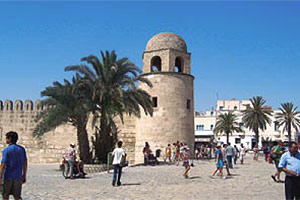Its territory can be divided into three distinct regions. The first is the region of the Atlas Mountains, which cross the country from southwest to northeast with peaks that range from 600 to 1,500 meters above sea level. Among these mountains there are some fertile plateaus and valleys, where the River Medjerda, the longest in Tunisia, flows. Towards the south, the mountains give way to a plateau at an average altitude of 600 meters above sea level. Farther south, the plateau declines into an area of salty lakes called shotts, almost at sea level.
Finally, the shotts blend into the Sahara Desert, which covers 40% of the total surface area of the country. In general terms, a Mediterranean climate predominates in the north, becoming more arid towards the south.
The population of Tunisia is made up of Arabs (96,2%), Berbers (1,4%) and other groups (Europeans, Jews, etc.), that account for 2,4% of the population. The Tunisian economy is based on agriculture (cereals, olive oil, wine, etc) and mining (petroleum, natural gas, phosphates, iron, etc). Tourism is also an important source of income.








